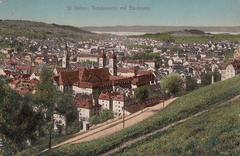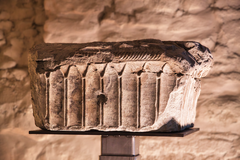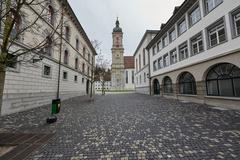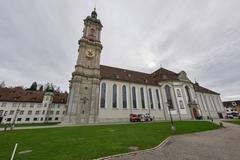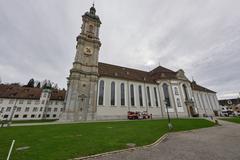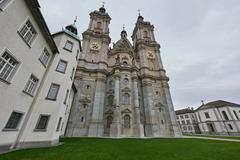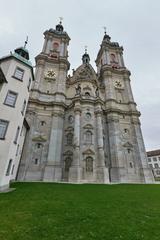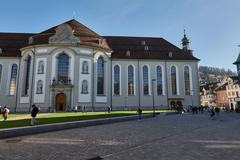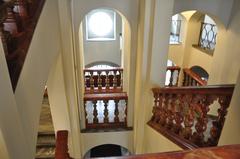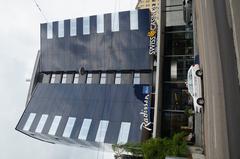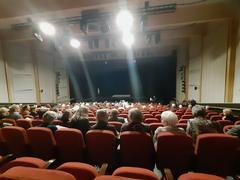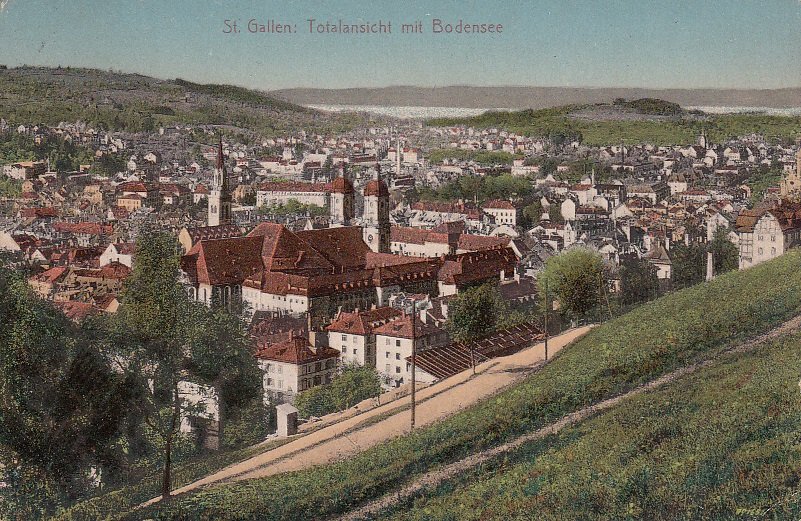
St. Gallen Cathedral Visiting Hours, Tickets, and Historical Sites Guide
Date: 14/06/2025
Introduction
Nestled in the heart of St. Gallen, Switzerland, St. Gallen Cathedral—formally known as the Stiftskirche St. Gallus und Otmar—is a masterpiece of Baroque architecture and a symbol of centuries of religious devotion and cultural achievement. Originating from a 7th-century hermitage founded by the Irish monk Saint Gallus, the site evolved into the influential Abbey of Saint Gall, renowned for its monastic scholarship and artistic treasures. Today, the cathedral and its Abbey District are UNESCO World Heritage sites, attracting visitors seeking history, architecture, and spiritual enrichment (The Rook and Queen; myswitzerland.com).
This guide delivers everything you need to plan your visit: up-to-date opening hours, ticket and tour options, accessibility information, travel tips, and highlights of nearby attractions within the Abbey District and St. Gallen’s charming Old Town.
Table of Contents
- Early Origins and Monastic Foundations
- Medieval Growth and Cultural Significance
- Architectural Evolution and Baroque Transformation
- Secularization and Modern Role
- Visiting St. Gallen Cathedral: Practical Information
- UNESCO World Heritage Status and Preservation
- The Cathedral’s Role in the Religious and Cultural Life of St. Gallen
- Architectural and Artistic Highlights
- Exploring the Abbey District and Surroundings
- Frequently Asked Questions (FAQ)
- Conclusion and Visitor Tips
- Sources
Early Origins and Monastic Foundations
The story of St. Gallen Cathedral begins in the 7th century with the hermitage of Saint Gallus. In 719, Saint Othmar established the Benedictine Abbey of Saint Gall, which quickly became a center of religious life and learning in medieval Europe. The abbey’s scriptorium and library attracted scholars, and its influence extended well beyond present-day Switzerland (The Rook and Queen).
Medieval Growth and Cultural Significance
By the 9th century, the Abbey of St. Gall had achieved independent principality status, wielding both spiritual and temporal power. Its library, founded in the 9th century, holds over 170,000 volumes today, including some of Europe’s oldest manuscripts and the famous Plan of St. Gall, an unparalleled example of early medieval architectural drawing (touristplaces.guide; myswitzerland.com).
Architectural Evolution and Baroque Transformation
The most significant transformation of the site came between 1755 and 1767, when architect Peter Thumb rebuilt the abbey church in the grand Baroque style. The resulting cathedral is characterized by twin 68-meter towers, dynamic exterior forms, and an interior adorned with elaborate stuccowork and frescoes by Josef Wannenmacher (explorial.com; Tourist Places Guide). The cathedral’s white-and-green interior, rose marble altars, and gilded altar screen create an atmosphere of heavenly grandeur (leisuregrouptravel.com).
Secularization and Modern Role
The Abbey was dissolved around 1800 during secularization, but in 1848 the church became the cathedral of the Diocese of St. Gallen. Today, it remains a vibrant spiritual and cultural center, hosting religious ceremonies, concerts, and community events (The Rook and Queen).
Visiting St. Gallen Cathedral: Practical Information
Visiting Hours
- Monday to Saturday: 9:00 AM – 5:00 PM
- Sunday: 12:00 PM – 5:00 PM
Hours may vary on public holidays and during special events. Always check the official website for up-to-date information.
Tickets and Admission
- Cathedral entry: Free
- Abbey Library: Separate ticket required (approx. CHF 10 for adults)
- Guided tours: Available seasonally; prices vary, advance booking recommended (myswitzerland.com)
Accessibility
- Wheelchair accessible entrances and restrooms
- Ramps at main entrances; assistance available on request
Guided Tours and Special Events
- Tours available in multiple languages, including the Abbey Library and crypts (when open)
- Annual festivals and concerts, such as the St. Gallen Festival, make use of the cathedral’s renowned acoustics (MySwitzerland.com)
Travel Tips
- Arrive early to avoid crowds, especially during festivals
- Photography is permitted, but restrictions apply during services or special events
- Wear comfortable shoes for exploring the cobbled Abbey District streets
- Public transportation and nearby parking are available
UNESCO World Heritage Status and Preservation
Since 1983, the Abbey District—encompassing the cathedral, library, and monastic buildings—has been recognized as a UNESCO World Heritage Site for its architectural integrity and cultural significance. Ongoing preservation efforts protect its Baroque architecture, frescoes, and invaluable archives (UNESCO).
The Cathedral’s Role in the Religious and Cultural Life of St. Gallen
St. Gallen Cathedral is the spiritual heart of the city, serving as the seat of the Bishop and the principal Roman Catholic church in the region. It hosts daily mass, major feast days, and ecumenical events. The crypt, dating to the 9th century, contains the tombs of Saint Othmar and other notable abbots and bishops (leisuregrouptravel.com). The cathedral’s bells, among Switzerland’s most complete historic sets, mark time and accompany liturgical celebrations.
Architectural and Artistic Highlights
Exterior
- Iconic twin towers and pastel pink façade
- Baroque statues and ornamentation above entrances (explorial.com; thisismysaintgallen.com)
Interior
- Three-nave basilica with a central cupola
- Intricate stucco work by the Gigl brothers, featuring over 800 putti and angels
- Vivid ceiling frescoes by Josef Wannenmacher, illustrating biblical stories and the life of Saint Gallus
- Sculptures by Joseph Anton Feuchtmayer and Johann Christian Wentzinger, including figures of Faith and Church
- Lavish choir stalls (84 walnut-wood seats), pulpit, confessionals, and marble altars
- One of Switzerland’s largest historic organs, renowned for its acoustics and regular concert performances (allaboutswiss.com; stiftsbezirk.ch)
Crypts and Relics
- Eastern crypt: houses the tomb and skull relic of Saint Gallus
- Western crypt: tombs of Saint Otmar and St. Gallen bishops
Exploring the Abbey District and Surroundings
Abbey Library
- Houses 170,000+ volumes and one of the world’s oldest monastic manuscript collections
- Rococo hall with ornate woodwork and frescoes (The Crazy Tourist)
Old Town
- Pedestrian-friendly streets with over 100 decorated Renaissance and Baroque bay windows
- Textile Museum, Gallusplatz Square, and charming cafes and shops
Additional Attractions
- Kunstmuseum St. Gallen, Botanical Garden, and Peter and Paul Wildlife Park are all within easy reach
Frequently Asked Questions (FAQ)
Q: What are St. Gallen Cathedral’s visiting hours?
A: Monday–Saturday 9:00 AM–5:00 PM; Sunday 12:00 PM–5:00 PM. Check the official website for updates.
Q: Is there an entrance fee?
A: Entry to the cathedral is free. Abbey Library and guided tours require tickets.
Q: Is St. Gallen Cathedral accessible?
A: Yes, with ramps and accessible facilities.
Q: Are guided tours available?
A: Yes, in multiple languages. Book online or at the visitor center.
Q: Can I take photos inside?
A: Photography is allowed, but respect restrictions during services.
Q: What else can I see nearby?
A: The Abbey Library, Old Town, Textile Museum, and more.
Conclusion and Visitor Tips
St. Gallen Cathedral is an enduring symbol of Switzerland’s religious, artistic, and cultural vitality. From its foundation as a 7th-century hermitage to its transformation into a Baroque masterpiece, the cathedral’s artistry and history invite exploration and reflection. Visitors are welcomed year-round with free entry, and can deepen their experience through guided tours, concerts, and exploration of the Abbey District and St. Gallen’s Old Town. For a richer visit, consider using the Audiala app for guided tours and audio content.
Plan your journey to St. Gallen Cathedral and immerse yourself in the legacy of this UNESCO-listed treasure.
Sources
- This is a sample text. (The Rook and Queen)
- This is a sample text. (leisuregrouptravel.com)
- This is a sample text. (explorial.com)
- This is a sample text. (The Crazy Tourist)
- This is a sample text. (UNESCO)
- This is a sample text. (stiftsbezirk.ch)
- This is a sample text. (Tourist Places Guide)
- This is a sample text. (MySwitzerland.com)
